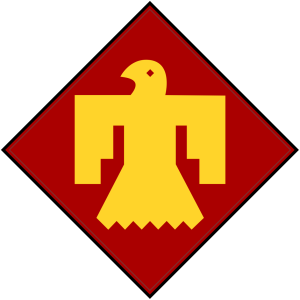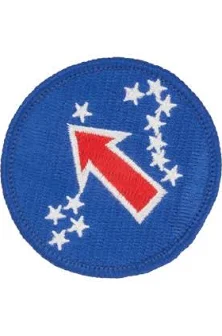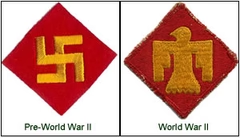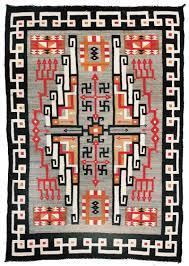From 1924-1939, an American infantry division incorporated the swastika into its unit patch.
File:Patch of the 45th Infantry Division (1924-1939).svg - Wikipedia
File:Patch of the 45th Infantry Division (1924-1939).svg - Wikipedia
From 1924-1939, an American infantry division incorporated the swastika into its unit patch.
File:Patch of the 45th Infantry Division (1924-1939).svg - Wikipedia
Sobel would have gotten fragged if he had actually gone into combat.
Sobel would have gotten fragged if he had actually gone into combat.
The 45th infantry division was comprised of mainly native Americans, from Oklahoma. That was a native American symbol for something or other, but got 'misconstrued' (well, it is a swastika, but not in their use) so they changed it to a buffalo I think.
When I was a kid I collected old military patches and crests, and always wanted that one, but is was so rare.
Historical insignia for the USA 45th Infantry Division. Note: The shoulder sleeve insignia (SSI) for the U.S. Army's 45th Infantry Division was approved in August of 1924 and featured a swastika, a symbol commonly used by Native Americans from the Mississippian culture. With the rise of Germany's Nazi Party, the 45th Division retired its original insignia and replaced it in 1939 with another Native American symbol called the Thunderbird.

This is from the Wikipedia media description.
This is the patch they switched it over to, when they dropped the swastika.
View attachment 44197
File:45th Infantry insignia (thunderbird).svg - Wikimedia Commons

The USARPAC patch is based on WWII happenings as well.
I used to think the patch was super lame until our CG explained the symbolism.
View attachment 44198
in addition to the info in the description, the red arrow is a giant red axis of advance pointed straight at... Japan.It's a bit more involved than I was expecting. It is a neat one though, once you read the description.
in addition to the info in the description, the red arrow is a giant red axis of advance pointed straight at... Japan.
I'll take it. ;)
I'm not sure, the first time I heard it explained was by our four-star at the end of a major joint/combined exercise. He's the one who told me (us) about the stars and the numbers and where the arrow pointed.That was my very first thought...I thought it odd that it wasn't mentioned in the description. Did that wording get removed after the war ended, or was it always implied, but never explicitly spelled out?
I'm not sure, the first time I heard it explained was by our four-star at the end of a major joint/combined exercise. He's the one who told me (us) about the stars and the numbers and where the arrow pointed.
I DEEPLY disliked my time at USARPAC for many reasons that had nothing to do with our CG. I also didn't like our patch, which to me looked like my 12 year old designed it in the 1995 version of Microsoft Paint. Because it does.
And having come from 101st, 5th Group, JSOC, etc., our patches looked way cooler and inspired far more pride. I cared so little about USARPAC that I didn't even bother to look up the history of our patch, I just talked shit about it. Whenever I would go places off the island wearing that patch, people didn't know what it was. At best they assumed it was a National Guard or Reserves unit.
But after the CG explained it, and the way he explained it... well I still deeply disliked the unit but I had a little more pride in the patch. Hidden things always appealed to me, and there's a lot hidden in that patch that you don't know just by looking at it.
This is from the Wikipedia media description.
This is the patch they switched it over to, when they dropped the swastika.
View attachment 44197
File:45th Infantry insignia (thunderbird).svg - Wikimedia Commons


So, they had the symbol of the Whirling logs....but everyone freaked....lol
View attachment 44201
The motif called the “Whirling Log” in Navajo culture is one appearance of one of the oldest symbols to be depicted by human beings. The symbol has been recorded in rock and cave paintings from at least 6,000 years ago and, in Navajo culture, the Whirling Log represents wellbeing, good luck, and protection.
View attachment 44202
When I was in Alaska, we always referred to the patch as the Fun Meter...almost always pegged.in addition to the info in the description, the red arrow is a giant red axis of advance pointed straight at... Japan.
that was certainly my experience... moral and enthusiasm at zero and going down fastWhen I was in Alaska, we always referred to the patch as the Fun Meter...almost always pegged.
If you didn't like MREs, remember, someone else always has it worse:
Years ago I heard a presentation from a SR-71 pilot, he talked about nutrition. And elimination. He said they had a protein -rich low-carb meal before the launcher which was supposed to reduce hunger and need to poop. Them are some dedicated pilots!
Steve1989MREInfo on Youtube has a few videos with them. Apparently they're not as bad as they sound.If you didn't like MREs, remember, someone else always has it worse:
